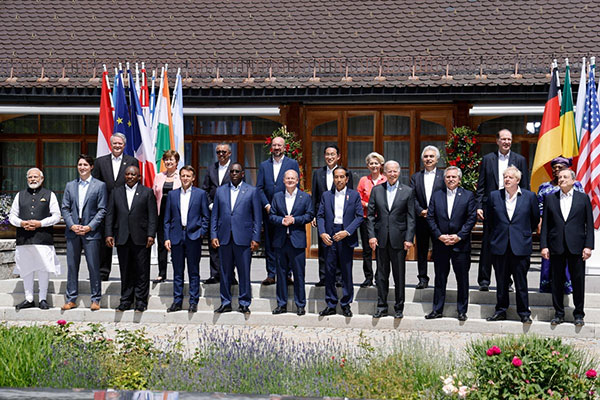The “family portrait” — or rather, the harmonic and determined togetherness it’s designed to demonstrate — is one goal of summitry in a time of war. So it was at last week’s European Union summit in Brussels and this week’s Group of Seven meeting in the Bavarian Alps. So it is once more as Nato leaders gather in Madrid.
The true narrative, like with authentic family portraits, is typically about who stands where and with what body language. And there are occasions when it is about who should be in the shot but isn’t.
At the G7 meeting, it was easier to put up a façade of togetherness. The group is tiny and homogeneous, representing prosperous democracies, and the mountains provided a suitably Brobdingnagian backdrop. The photo represented a strong and united front against Russian President Vladimir Putin, who attended these symposiums while they were still known as the G8, until he was barred from attending following his first war on Ukraine in 2014.
Another shot from the top requires a more detailed narrative. It depicts the same G7, but with leaders from “partner nations” in the so-called Global South included. These include South Africa, Senegal, and Argentina, as well as Indonesia and India, which will host the G20 this year and next, respectively, a larger conference in which Putin is scheduled to speak awkwardly.
The G7 host, German Chancellor Olaf Scholz, asked these visitors to prod their nations, and even continents, to join the West in opposing Putin in particular, and autocrats in general. Getting them in the family portrait, however, is not the same as evoking that commitment.
These nations were members of the non-aligned movement during the Cold War. Its nations allied with neither the free nor the communist blocs (the “first” and “second” worlds, respectively), and hence became known as the Third World, though that word eventually took on a whole other meaning.
Today, many nations in Asia, Africa, and South America are wary of assisting in confronting Putin over what they regard as a remote regional conflict that will not be resolved.
The G7, as they view it, isn’t normally particularly concerned about regional wars in Africa or Asia.
The captions will also be complicated by images shot in Madrid when Nato’s 30 members gather there. Transatlantic allies are more unified than they have been since the Cold War in confronting Putin. They have strengthened their eastern flank, for example, and will implement a new plan to better secure Estonia, Latvia, and Lithuania.
However, the bond, like other families, is strained. Turkey, in particular, has always been a tough and volatile ally, behaving more like a rival than a friend toward fellow Nato member Greece.
According to Yevgeniya Gaber of the Atlantic Council, Turkey has performed a diplomatic “balancing act” between Russia and Ukraine since Putin’s assault on Ukraine this year.
Worse, Recep Tayyip Erdogan, Turkey’s president, is effectively holding two non-aligned but Western states hostage. Sweden and Finland, both EU members but not yet Nato members and possibly in Putin’s crosshairs, seek to join the alliance. Nato wants them as members as well, because the well-armed Scandinavians might aid in the defense of the Baltic states. However, Erdogan is threatening a veto, ostensibly for domestic political reasons.
The Swedes and Finns are now in a dangerous no-land. man’s They’ve declared their commitment and plan to join Nato, which has enraged Putin, but they still lack the security of the alliance’s mutual-defense clause. They’re not in or out.
Turkey is in a new kind of no-land man’s as a result of Erdogan’s myopia. Geopolitically, it is neither entirely in nor fully out of the West, neither truly democratic nor completely dictatorial, neither trustworthy nor hostile. What type of ally will it be, if any at all?
Other countries in the area are in the same situation. Several Balkan countries, as well as Ukraine, Moldova, and Georgia, desire to join the EU but realize it will take decades, if the EU says yes even then.
In the meanwhile, how will Serbia, for example, place itself between Europe and its old buddy Russia?
Then there’s the rest of the world, from Asia to Africa and South America, which is home to the majority of the world’s population yet is only marginally represented in the Bavarian Alps this week. For the time being, these countries would rather hedge their chances and remain non-aligned, as they did throughout the Cold War.
After they’ve finished traveling between summits and posing for photos with one another, the leaders of the West have a job to perform.
They must save the rest of the globe from this wasteland. As a result, they should provide considerable assistance – in dollars, euros, and other currencies – to nations that vow to assist in protecting global democracy against the autocrats in Moscow and Beijing.
They should also warn these countries that non-alignment is not an option indefinitely. As South Africa’s beloved archbishop, the late Desmond Tutu, famously observed, “If you are neutral in instances of injustice, you have taken the side of the oppressor.” If an elephant has its foot on the tail of a mouse and you claim to be neutral, the mouse will not be pleased.” Putin is the giant today, and Ukraine is the mice. And no-land man’s is a dangerous place to be.

